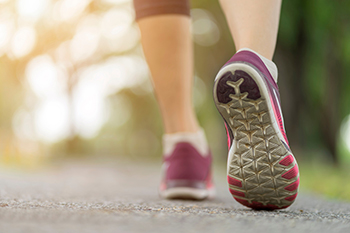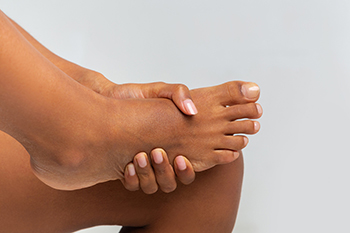Connect With Us
Blog
Items filtered by date: November 2024
Exercises for Healthier Feet

Engaging regularly in foot exercises can improve flexibility, strength, and range of motion, which are essential for overall foot health. Strengthening exercises, like toe curls and marble pickups, enhance muscle support and help protect your feet during daily activities. Stretching exercises, such as Achilles tendon stretches and toe extensions, can reduce stiffness, alleviate pain, and ward off issues like plantar fasciitis and hammertoes. Integrating these exercises into your routine, three times a week or more can help maintain flexibility and strength over time. A chiropodist can guide you in creating a personalized exercise routine to address your specific foot health needs, particularly if you have conditions like arthritis or diabetes. A chiropodist can ensure that the exercises you perform are safe and effective, as well as add specific exercises for your foot problems. If you regularly experience foot pain or weakness, it is suggested that you schedule an appointment with a chiropodist for advice.
Stretching and strengthening your feet is very important for maintaining your foot health. If you would like to learn more about exercises for your feet, please consult with Paul A. Scotti, D.Ch from West Toronto Foot & Ankle Clinic Inc. . Our chiropodist can help you maintain the health of your lower limbs and your mobility.
There are a variety of relatively easy-to-do exercises that can boost the strength, flexibility, and mobility of your feet, as well as relieve foot pain.
Strength exercises:
Toe splay - Spread the toes apart and hold for several seconds; improves control over toe muscles
Toe curls - Scrunch up a towel with your toes; strengthens the flexor muscles
Marble pickup - Pick up marbles with your toes; strengthens the muscles on the undersides of the feet and toes
Walking on sand - Stretches and strengthens feet and calves
Flexibility exercises:
Heel raises - Raise the heels while keeping toes on the ground
Toe point - Raise the heels while pointing the toes, keeping just the tips of toes on the ground
Toe curl - Raise the heels while curling the toes inwards, keeping just the tips of toes on the ground
Big toe stretch - Use your hands to gently stretch your big toes up, down, and to the side
Exercises for foot pain:
Toe extension - Gently pull the toes up towards the ankle and hold for several seconds
Ball roll - gently roll a golf or tennis ball underneath the arches of the feet
If you have any questions, please feel free to contact our office located in . We offer the newest diagnostic and treatment technologies for all your foot care needs.
Essential Traits of Walking and Running Shoes

Choosing the right walking shoes is vital for comfort and performance. One key trait is how the shoe facilitates weight transfer, allowing for a smooth roll from the heel through the ball to the toe. This motion helps in maintaining a natural gait and reducing fatigue. Flexibility is another important factor, and shoes that allow for natural foot movement enhance comfort during longer walks. Unlike running shoes, walking shoes often feature more cushioning to absorb impact while remaining lightweight. Conversely, running shoes have a higher amount of mesh in the shoe's design and promote breathability, helping to keep feet cool and dry by absorbing heat. These essential traits contribute to a more enjoyable walking or running experience. If you have endured a foot injury from wearing the wrong type of shoes while walking or running, it is suggested that you consult a chiropodist who can treat various foot injuries, and guide you on appropriate shoe choice.
Finding the right shoes can sometimes be a major hassle, especially if you intend to work out in them. There are shoes on the market designed specifically for running and walking, but it can be difficult to differentiate between the two and find the right shoes for you. If you’re having trouble finding the right shoes, please consult with Paul A. Scotti, D.Ch from West Toronto Foot & Ankle Clinic Inc. . Our chiropodist can help you maintain the health of your lower limbs and your mobility.
What are the differences between running and walking shoes?
These two types of shoes vary along several parameters.
Cushioning: Runners need more cushioning in the heel and forefoot areas of the shoe, while walkers can get away with less cushioning.
Heel height: Runners need a higher heel to provide them with stability, but the ideal height of the heel for runners varies depending on their running gait. Walkers generally don’t need a built-up heel.
Heel flare: Flared heels can help provide extra stability for runners with certain gaits, while walkers may benefit from a flared heel to control the motion of their foot.
Flexibility: Both runners and walkers need shoes that are flexible.
For more information about the differences between walking and running shoes, and to figure out which shoes may be right for you, please consult with a chiropodist. Feel free to contact our office located in . We offer the newest diagnostic and treatment technologies for all your foot care needs.
Who Is Prone to Athlete’s Foot?

Athlete's foot is a common fungal infection that affects the skin of the feet, typically causing itching, burning, and redness. It often begins between the toes and can spread to the soles and sides of the feet, resulting in peeling, cracking, and sometimes blisters. The infection is caused by fungi known as dermatophytes, which thrive in warm, damp environments like public showers or swimming pools. Risk factors include wearing tight or non-breathable shoes, having sweaty feet, and sharing personal items such as towels or shoes. Poor foot hygiene and a weakened immune system can also increase susceptibility. If you have developed this uncomfortable condition, it is suggested that you confer with a chiropodist who can offer effective relief and treatment solutions.
Athlete’s foot can be uncomfortable and unsightly. To learn more about preventing and treating this condition, please consult with Paul A. Scotti, D.Ch from West Toronto Foot & Ankle Clinic Inc. . Our chiropodist will assess your condition and provide you with quality foot and ankle treatment.
What Is Athlete’s Foot?
Athlete’s foot refers to an infection of the skin on the feet that is caused by a fungus. This fungus is contagious and thrives in warm and moist environments. It is often spread in common areas such as public pools, locker rooms, and showers. It can also spread when sharing personal items, like shoes or towels, with an infected person.
Symptoms
The symptoms of athlete’s foot may include:
Itching, stinging, or burning of the skin on the feet
Cracking or peeling skin, especially between the toes and on the soles of the feet
Scaly, red rash on the foot
Blisters
Foul odor
Treatment
Treatment for athlete’s foot typically involves using over-the-counter topical antifungal medications on the feet. When over-the-counter options are ineffective, you may need to take prescription oral medications or topical antifungal drugs, or a combination of both.
Prevention
Preventing athlete’s foot places an emphasis on good foot hygiene practices.
You can prevent athlete’s foot by:
Washing and drying your feet thoroughly every day
Wearing shoes when walking in public areas
Not sharing personal items, like shoes or socks, with others
Wearing shoes and socks made out of breathable materials
If you have any questions, please feel free to contact our office located in . We offer the newest diagnostic and treatment technologies for all your foot care needs.
Wounds That Don't Heal Need to Be Checked
Why Does the Top of My Foot Hurt?

Pain on the top of the foot can stem from various causes, impacting mobility and overall comfort. One common reason is extensor tendonitis, which occurs when the tendons that run along the top of the foot become inflamed due to overuse or repetitive strain. This condition often affects athletes or individuals engaging in high-impact activities. Another potential cause is a stress fracture, which can result from increased physical activity or insufficient recovery time, leading to tiny cracks in the bones. Wearing improper footwear also can contribute to discomfort by failing to provide adequate support. Conditions such as arthritis or nerve compression can lead to pain in this area as well. It is suggested that you consult a chiropodist if you have pain in this part of your foot. This type of healthcare professional can accurately diagnose and treat various types of foot pain.
Foot pain is a common problem treated by chiropodists. If you have foot pain, please consult with Paul A. Scotti, D.Ch from West Toronto Foot & Ankle Clinic Inc. . Our chiropodist can help you maintain the health of your lower limbs and your mobility.
When you are experiencing foot pain, it’s important to note the type of pain and its location, as this can help determine a diagnosis.
Pain in the top of the foot may be caused by:
Stress fractures
Sinus tarsi syndrome
Extensor tendonitis
Tibialis anterior tendonitis
Gout
Athlete’s foot
Ganglion cysts
Pain in the bottom of the foot may be caused by:
Plantar fasciitis
Foot cramps
Tarsal tunnel syndrome
Plantar fibromatosis
Posterior tibial tendonitis
Stress fractures
Flat feet
Pain on the side of the foot may be caused by:
Ankle sprain
Cuboid syndrome
Peroneal tendonitis
Stress fractures
Bunions
Corns or calluses
Posterior tibial tendonitis
Heel pain may be caused by:
Plantar fasciitis
Achilles tendonitis
Bone spurs
Heel fractures
Retrocalcaneal bursitis
Sever’s disease
Pain in the toes may be caused by:
Gout
Hammertoe
Turf toe
Bunions
Ingrown toenails
Blisters
Arthritis
These and many more conditions can be treated by a chiropodist. If you have any questions, please feel free to contact our office located in . We offer the newest diagnostic and treatment technologies for all your foot care needs.
Blog Archives
- April 2025
- March 2025
- February 2025
- January 2025
- December 2024
- November 2024
- October 2024
- September 2024
- August 2024
- July 2024
- June 2024
- May 2024
- April 2024
- March 2024
- February 2024
- January 2024
- December 2023
- November 2023
- October 2023
- September 2023
- August 2023
- July 2023
- June 2023
- May 2023
- April 2023
- March 2023
- February 2023
- January 2023
- December 2022
- November 2022
- October 2022
- September 2022
- August 2022
- July 2022
- June 2022
- May 2022
- April 2022
- March 2022
- February 2022
- January 2022
- December 2021
- November 2021
- October 2021
- September 2021
- August 2021
- July 2021
- June 2021
- May 2021
- April 2021
- February 2021
- January 2021

